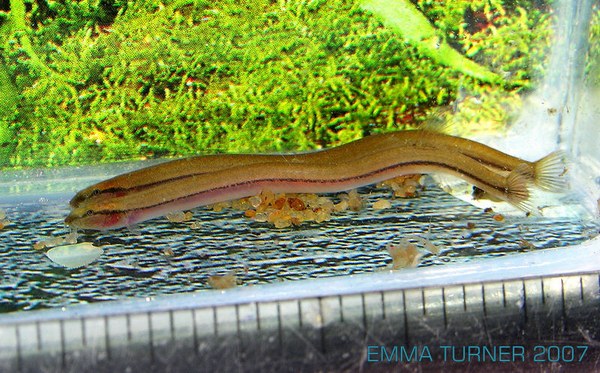Pangio cf. anguillaris
Summary

Scientific name: Pangio cf. anguillaris
Common name: Brown Eel Kuhli Loach
Synonyms: None
Distribution: Unknown
Sexual Dimorphism: Gravid females appear fuller
bellied.
Maximum size: Approx. 4"
(10cm)
Similar to: Pangio anguillaris, Pangio doriae
Care: This social species should only be added
to mature aquaria. Ideally the tank will have a substrate of soft sand which
will protect the skin and sensory barbels, and enable these loaches to burrow.
They do tend to dig out areas underneath rocks, so ensure that any structures
are secure. A really gregarious species, Brown Eel Kuhli Loaches should be
maintained in large groups. Three would be considered the absolute bare minimum,
but groups of 6+ are best. These fish have actually been observed congregating
in huge shoals (or 'knots') underneath rocks during the evening time, so if the
space is available, keeping a group of more than 20 makes for very interesting
viewing. The tank should contain plenty of live plants and have a gentle water
current. Frequent partial water changes will help to keep these fish in tip-top
condition.
 Feeding: Sinking
catfish pellets, sinking granular foods, flake/crisps (add with your fingers
underwater to ensure these sink), frozen foods such as mosquito larvae, daphnia
and cyclops. May also nibble at algae wafers.
Feeding: Sinking
catfish pellets, sinking granular foods, flake/crisps (add with your fingers
underwater to ensure these sink), frozen foods such as mosquito larvae, daphnia
and cyclops. May also nibble at algae wafers.
Water parameters: pH: 6.0-7.0. Hardness:
Soft-medium. Max dh: 12.
Temperature: 75ºF to 79ºF (24-26°C)
Breeding: To date, this species
has not been bred in the home aquarium.
Notes
This species was first imported during
June 2007 and erroneously labelled as Pangio
cf. piperata. It is clearly closer to that of Pangio anguillaris, and so, for now, we will
refer to it as Pangio cf. anguillaris
until more is known. The lateral stripe is considerably darker and more defined in this species than regular P. anguillaris.
Photo Gallery
Click to view all images of this species! |
|
Document Actions


